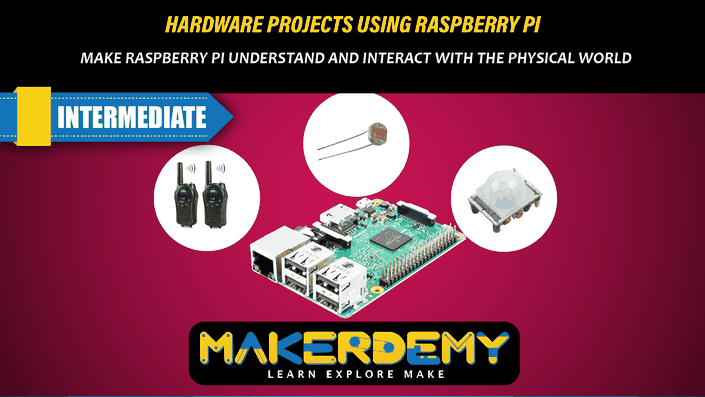
Hardware projects using Raspberry Pi
Learn how to use GPIO pins of Raspberry Pi to create hardware projects and interact with the physical world.


This is a follow on course to the #1 Raspberry Pi course "Introduction to Raspberry Pi"
This is an intermediate course about the credit card sized computer Raspberry Pi. This course is ideal for those who are interested in exploring the possibilities of Physical computing with Raspberry Pi. The course assumes basic knowledge on computer programming. However, knowledge of Linux operating system and Python programming language would greatly help you in getting up to speed.
The GPIO pins on a Raspberry Pi are a great way to interface with physical devices like resistors and sensors with the little Linux processor. If you're a Python lover, there's a sweet library called RPi dot GPIO that handles interfacing with the pins.
You will learn 3 complete hardware projects. The first one teaches you how to build a Walky Talky to make the most of your Raspberry Pi using Linux command. You just have to enter the desired frequency and you can talk to your neighbors without paying any operator charges!
The second project involves building a light detector mechanism which let you know the amount of light available in the particular area. The Raspberry Pi hardware uses a computer program written in Python. You will hook the Pi up with light detector circuit and will use the program to know the sensor behavior upon different intensities of light.
The third project teaches you to build a motion sensor based teddy bear which laughs upon waving our hand. The motion detector circuit will be embedded inside the teddy bear and will be controlled using a program written in Python to sense the motion.
What are you waiting for? Enroll now!
The course provides the complete source code for all the three hardware projects.
The entire course can be completed over a fortnight, including the hardware assembly and coding in Python.
By the end of this course, you can build your own Raspberry Pi controlled physical devices. You will also learn how to write your own python code to interact directly with the physical world.
Your Instructor

Venkatesh Varadachari is the founder of MAKERDEMY, a pioneer company in the field of maker education.
MAKERDEMY is a pioneer in teaching technology related maker courses online.
Venkatesh has an MBA from the prestigious Indian Institute of Management, Bangalore.
He also has a degree in Electrical Engineering from Madras University and a Masters in Financial Engineering from National University of Singapore.
Course Curriculum
-
PreviewIntroduction and Hardware Requirements (2:18)
-
PreviewConcept behind FM frequency (2:17)
-
PreviewAttaching Antenna to Raspberry Pi (2:03)
-
StartCircuit Diagram - Walky Talky
-
PreviewLinux command to transmit voice (3:16)
-
StartLinux Command to emit audio frequency
-
PreviewTransmit your voice at particular frequency (1:18)
-
StartLive testing of Walky Talky Project (1:58)
-
StartQuiz 1 : Walky Talky
-
StartIntroduction and Hardware Requirements (1:38)
-
StartDetailed description of the hardware components (4:44)
-
StartBonus Content : Light Dependent Resistor - Working Principle
-
StartAssembling the light detector circuit (2:49)
-
StartCircuit Diagram - Light detector mechanism
-
StartBegin Code - Import the requirted Python library (2:54)
-
StartCode for Light detector - Define Light detector function (3:12)
-
StartCode for Light detector - Declare if block (3:43)
-
StartCode for Light detector - ELIF condition (2:54)
-
StartCode for Light detector - Else condition (3:54)
-
StartError debugging and testing (1:18)
-
StartSource Code - Light detector mechanism
-
StartLive Demonstration of Light detector mechanism (2:08)
-
StartQuiz 2 - Light Detector Resistor
-
StartIntroduction and Hardware Requirements (1:41)
-
StartWorking theory of PIR motion sensor (2:12)
-
StartWiring and assembling PIR sensor circuit (2:05)
-
StartCircuit diagram - Laughing Teddy Bear
-
StartBegin Code - Import Python library required files (4:12)
-
StartCode for Motion Detection - Define TRY block (3:02)
-
StartCode for Motion Detection - Define If block (6:19)
-
StartCode for Motion Detection - Define Else block (4:25)
-
StartCode for Motion Detection - Define Exception Block (2:58)
-
StartError Debugging and testing (2:41)
-
StartSource Code - Laughing Teddy Bear
-
StartLive demonstration of Laughing Teddy Bear (3:03)
-
StartQuiz 3 - Motion Sensor
